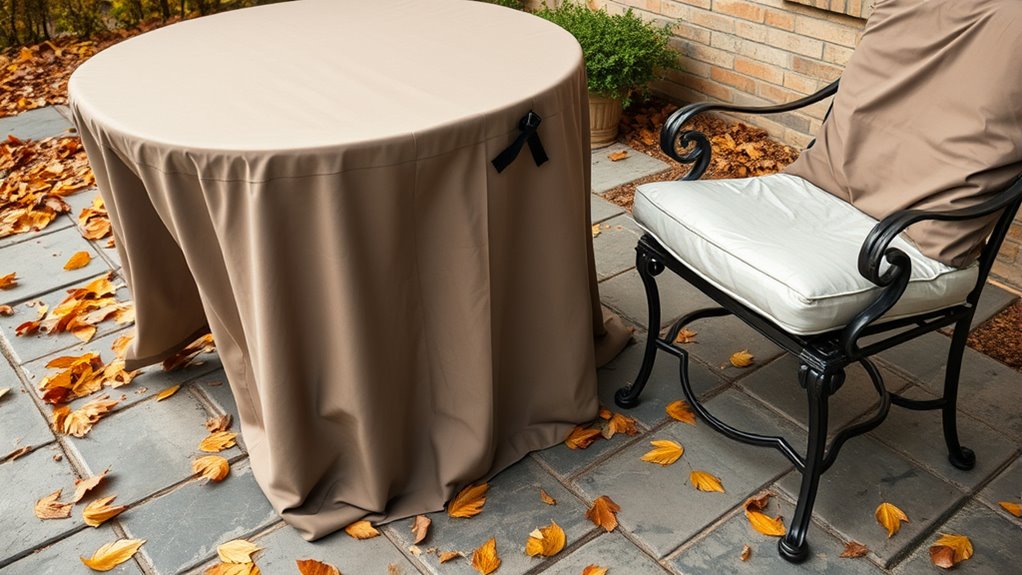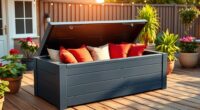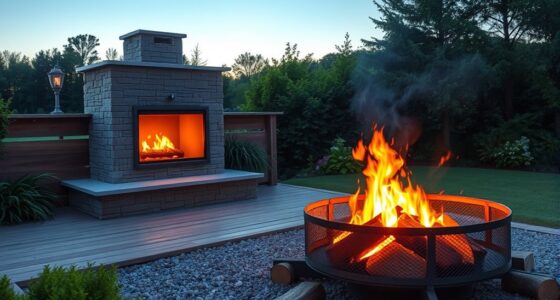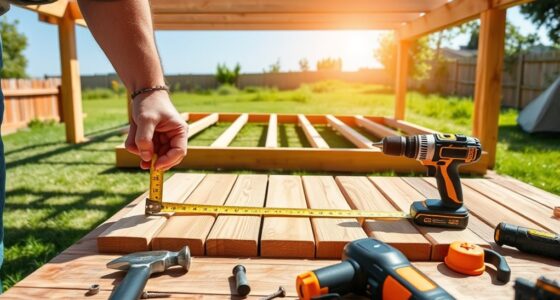To winterize your patio furniture, start by cleaning it thoroughly with mild soap and water, then dry completely to prevent mold. Inspect for damage, tighten loose parts, and repair cracks. For wood, apply a water-resistant sealant; for metal, remove rust and add protective paint. Cover furniture with waterproof, custom-fit covers or store it indoors in a dry, ventilated space. Elevate and store cushions separately. Continuing will help you learn more tips to protect your outdoor investment.
Key Takeaways
- Clean and dry all furniture thoroughly, removing dirt, debris, and cushions; store cushions indoors or in waterproof containers.
- Inspect for damage, tighten loose screws, repair cracks, and apply water-resistant sealants or protective coatings.
- Cover furniture with custom-fit, waterproof, tear-proof covers, securing them properly and avoiding covering damp furniture.
- Store furniture indoors or in a dry, ventilated area, elevating it off the ground to prevent moisture absorption.
- Regularly inspect, reapply protective coatings, and rotate stored furniture to extend lifespan and maintain condition.

Winterizing your patio furniture is essential to protect it from the harsh elements and extend its lifespan. Cold temperatures, moisture, and wind can cause significant damage if you don’t take the right steps. Start by thoroughly cleaning your furniture. Use mild dish soap, warm water, and a sponge for most materials to remove dirt, debris, and stains that could lead to mold or rust. For delicate fabrics or cushions, seek special cleaners designed for those surfaces. Make sure your furniture is completely dry before moving on to any covering or storage; trapping moisture can cause mildew and deterioration. Remove cushions and pillows, cleaning them separately and storing them in dry, waterproof containers to prevent mold growth.
Thoroughly clean and dry your patio furniture before winter to prevent mold, rust, and damage.
Next, inspect your furniture for damage. Tighten loose screws, repair cracks, and address any wear before storing or covering it. If you have wooden furniture, water is your primary enemy. Apply a water-resistant sealant or protectant at least twice a year, especially before winter. Use polyurethane sealants with UV blockers to shield the wood from sun damage and preserve its color. Seal any cracks or exposed areas to prevent water infiltration, which can cause expansion, warping, or rot during freezing temperatures. Sand worn spots and reapply sealant to maintain full protection. Additionally, regularly checking for signs of insect infestation or wood decay can help catch issues early. Keeping your outdoor furniture elevated off the ground can also help prevent moisture absorption and prolong its life.
Metal and aluminum furniture need similar attention. Remove rust or corrosion with appropriate cleaners before applying primers and fresh coats of paint. This restores protective layers and prevents further rusting. Use paste wax on metal surfaces to create a barrier against oxidation and sun damage. Lubricate hinges, joints, and moving parts to prevent freezing and cracking during cold weather. For wrought iron or vulnerable metals, consider rust neutralizers before applying protective finishes. Proper storage in a dry, ventilated area can also significantly reduce the risk of corrosion and prolong the life of metal furniture.
Covering your furniture offers additional protection. Use custom-fit, tear-proof, waterproof covers secured with straps or ties to withstand strong winds. Avoid covering wet or damp furniture, as trapped moisture fosters mold and mildew. During warmer periods, remove covers to let furniture air out and dry thoroughly. This practice helps keep your outdoor space organized and minimizes cleaning chores come spring. Remember, UV-resistant covers can help prevent sun damage and fading over time.
Whenever possible, store your furniture indoors or in a sheltered area like a garage, shed, or covered porch. Indoor storage protects from extreme cold, moisture, and wind damage. If space is limited, store pieces upright and avoid stacking heavy items that could warp or damage the furniture. Remove cushions and store them separately in dry, waterproof containers to prevent moisture damage. Rotating stored furniture periodically helps prevent pressure points and maintains its shape. Additionally, elevating furniture slightly off the ground on pallets or blocks can help prevent moisture absorption from the floor. Using protective coatings can further shield your furniture from winter weather and extend its durability.
Finally, take care of fabric cushions by cleaning and drying them completely before winter. Applying water-repellent fabric protectors can reduce staining and water absorption. Store cushions indoors or in waterproof bags to prevent mildew and fabric degradation. Proper winterization saves you time and money in the long run by keeping your patio furniture in top condition for years to come. Regular maintenance, such as reapplying protective coatings and inspecting for damage, can further extend the life of your outdoor furnishings.
Frequently Asked Questions
Can I Winterize Outdoor Furniture Without Removing Cushions?
You might wonder if you can winterize your outdoor furniture without removing cushions. While it’s possible, it’s not ideal. Cushions are vulnerable to moisture, mold, and damage from snow and rain. To safeguard them, use waterproof covers or bags if you keep them outside. Alternatively, storing cushions indoors or in a dry, secure space guarantees they stay in good condition and prolongs their lifespan for the next season.
How Often Should I Reapply Protective Coatings During Winter?
You might wonder how often to reapply protective coatings during winter. Generally, you should inspect your furniture regularly and reapply every 2 to 3 years for wood, or more frequently if exposed to harsh weather. For metal surfaces, look for rust or damage and recoat as needed. Keep an eye on the coating’s condition, especially after storms or temperature fluctuations, to guarantee your furniture stays protected throughout winter.
Is It Necessary to Cover All Types of Patio Furniture?
You might wonder if covering all your patio furniture is necessary. While high-quality, weather-resistant pieces like all-weather wicker or metal may withstand winter outdoors, covering is still wise to prevent debris buildup, UV damage, and weathering. For less durable materials like untreated wood or cushions, covers or indoor storage are essential to avoid warping, mold, and damage. Covering your furniture helps prolong its lifespan and keeps it looking fresh.
What Is the Best Way to Remove Mold Before Winterizing?
Think of mold as a silent invader that threatens your outdoor sanctuary. To banish it, start by removing loose spores with a brush or vacuum. Check your furniture’s care label, then choose a suitable cleaning solution—vinegar, borax, or mild soap. Scrub affected areas thoroughly, rinse well, and dry in sunlight. This vigilant effort keeps your furniture healthy, ready to shine come spring, and prevents mold from taking root again.
Can I Leave My Furniture Outside if I Don’T Winterize?
You can leave your furniture outside without winterizing, but it’s risky. Exposure to moisture, freezing temperatures, and UV rays can cause cracks, rust, and fading over time. Heavy snow and ice buildup might also damage lightweight or porous materials. To protect your furniture, consider covering it with waterproof covers, cleaning regularly, and inspecting for damage. Otherwise, storing it indoors or in a sheltered area is the best way to preserve its condition.
Conclusion
Now that you know how to winterize your patio furniture, you can enjoy a worry-free outdoor space all season long. Properly stored furniture not only looks better but also lasts longer, saving you money in the long run. Are you ready to give your patio the care it deserves? With these simple steps, you’ll be prepared to face winter head-on and keep your outdoor oasis in top shape for years to come.









